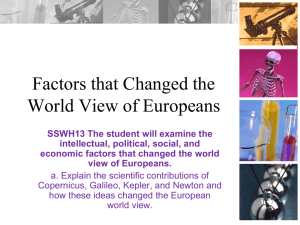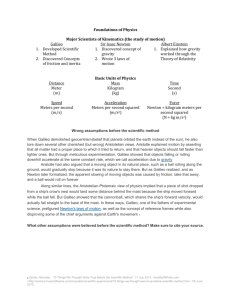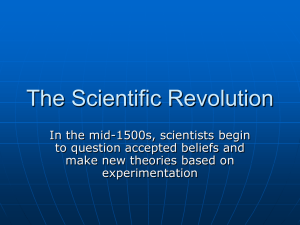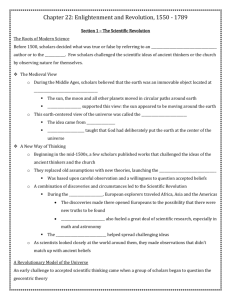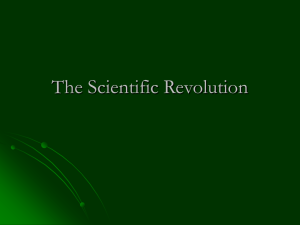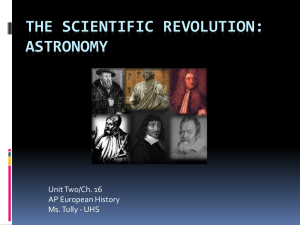History of Scientific Discover: 1500 to Present
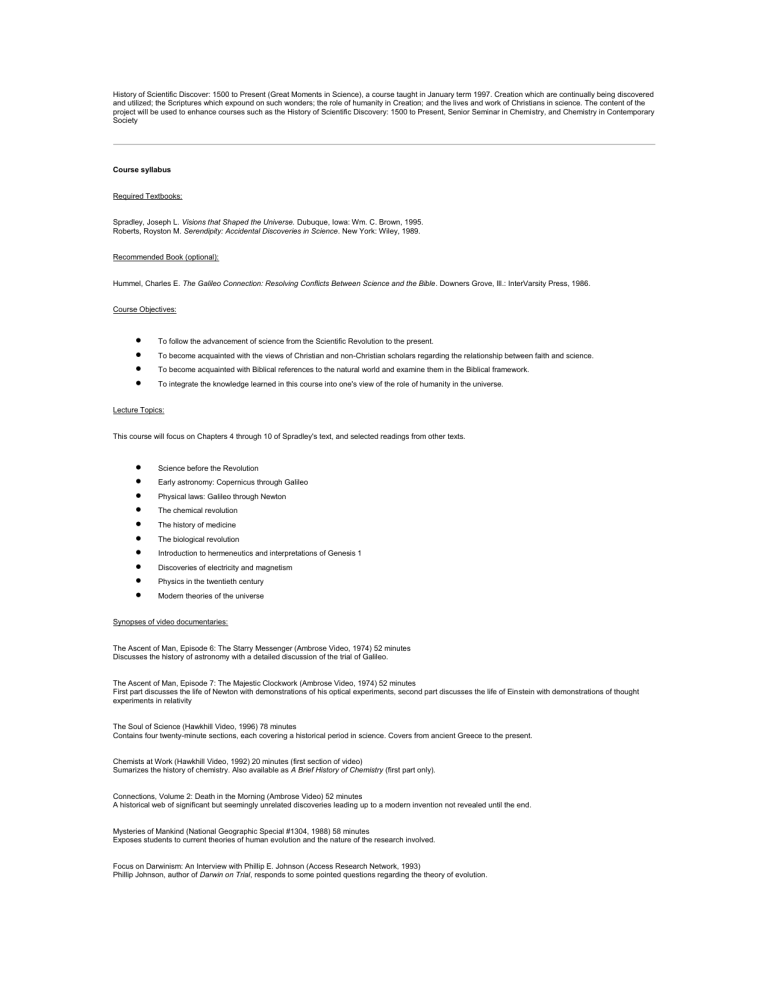
History of Scientific Discover: 1500 to Present (Great Moments in Science), a course taught in January term 1997. Creation which are continually being discovered and utilized; the Scriptures which expound on such wonders; the role of humanity in Creation; and the lives and work of Christians in science. The content of the project will be used to enhance courses such as the History of Scientific Discovery: 1500 to Present, Senior Seminar in Chemistry, and Chemistry in Contemporary
Society
Course syllabus
Required Textbooks:
Spradley, Joseph L. Visions that Shaped the Universe.
Dubuque, Iowa: Wm. C. Brown, 1995.
Roberts, Royston M. Serendipity: Accidental Discoveries in Science . New York: Wiley, 1989.
Recommended Book (optional):
Hummel, Charles E. The Galileo Connection: Resolving Conflicts Between Science and the Bible . Downers Grove, Ill.: InterVarsity Press, 1986.
Course Objectives:
To follow the advancement of science from the Scientific Revolution to the present.
To become acquainted with the views of Christian and non-Christian scholars regarding the relationship between faith and science.
To become acquainted with Biblical references to the natural world and examine them in the Biblical framework.
To integrate the knowledge learned in this course into one's view of the role of humanity in the universe.
Lecture Topics:
This course will focus on Chapters 4 through 10 of Spradley's text, and selected readings from other texts.
Science before the Revolution
Early astronomy: Copernicus through Galileo
Physical laws: Galileo through Newton
The chemical revolution
The history of medicine
The biological revolution
Introduction to hermeneutics and interpretations of Genesis 1
Discoveries of electricity and magnetism
Physics in the twentieth century
Modern theories of the universe
Synopses of video documentaries:
The Ascent of Man, Episode 6: The Starry Messenger (Ambrose Video, 1974) 52 minutes
Discusses the history of astronomy with a detailed discussion of the trial of Galileo.
The Ascent of Man, Episode 7: The Majestic Clockwork (Ambrose Video, 1974) 52 minutes
First part discusses the life of Newton with demonstrations of his optical experiments, second part discusses the life of Einstein with demonstrations of thought experiments in relativity
The Soul of Science (Hawkhill Video, 1996) 78 minutes
Contains four twenty-minute sections, each covering a historical period in science. Covers from ancient Greece to the present.
Chemists at Work (Hawkhill Video, 1992) 20 minutes (first section of video)
Sumarizes the history of chemistry. Also available as A Brief History of Chemistry (first part only).
Connections, Volume 2: Death in the Morning (Ambrose Video) 52 minutes
A historical web of significant but seemingly unrelated discoveries leading up to a modern invention not revealed until the end.
Mysteries of Mankind (National Geographic Special #1304, 1988) 58 minutes
Exposes students to current theories of human evolution and the nature of the research involved.
Focus on Darwinism: An Interview with Phillip E. Johnson (Access Research Network, 1993)
Phillip Johnson, author of Darwin on Trial , responds to some pointed questions regarding the theory of evolution.
The Day After Trinity (Pyramid Films, 1980) 88 minutes
A historical documentary on the life of J. Robert Oppenheimer, leader of the Manhattan Project to build the atomic bomb. Includes coverage of the Manhattan
Project and its effect on the participants.
The Astronomers: A Window to Creation (PBS Home Video, 1991) 60 minutes
A documentary of three modern research projects related to the Big Bang Theory. Gives insights into the puzzles involved in the Big Bang Theory as well as a look at the process of scientific research. Suitable for a general audience.
Activity:
Visit to the Chicago Museum of Science and Industry
Expectations:
The expected norm for most college courses, including this one, is for students to work approximately two hours outside the classroom for every hour spent inside the classroom. Course assignments will be given with this expectation in mind; therefore it is important to keep up with the daily work. For papers and exam preparation, the time spent outside the classroom may be more than this, depending on the individual.
Course Policies:
According to the college catalog, missing one-third of classes will result in failure of the course. This means that in this J-term course, you cannot miss more than three days and still pass. Since each day consists of two hours of class, missing one hour will count as half an absence. If you are late for class, it is your responsibility after class to remind the instructor to record you as present that day; otherwise you may be recorded as absent.
Exams and quizzes must be taken at the scheduled time unless approval is obtained in advance. Should you find that you are sick on the day of a test, you must call me BEFORE the test.
Assignments are due at the beginning of class on the designated due date. Late papers or assignments will receive a deduction of 10 percent per day. Also, no work will be accepted past 1 week after the due date, unless valid medical reasons are shown.
Plagiarism is using the information or wording of another person without proper acknowledgment. Plagiarism includes copying previous papers written by you for a previous course, unless quoted like any other reference. Unless otherwise stated, you may freely discuss assigned projects or problem sets with others, but the answers or essays must be in your own words, reflecting what you have thought about rather than simply reflecting others' ideas.
Grading
Total daily quiz scores: 100 points (lowest quiz grade will be dropped)
Midterm exam: 100 points
Comprehensive final exam: 100 points
Paper and Presentation: 100 points
Miscellaneous (includes assignments, projects, in-class activities): up to 100 points (see note below)
Note: Consistency and thoroughness in completing homework assignments on time will be considered when deciding the final course grade.
Grading Scale
A 90-100%
B 80-89%
C 70-79%
D 60-69%
F 59% or below
Tentative schedule of activities and assignments.
Daily activities (9-11:10 am):
Daily reading quiz (5 to 15 min).
Lecture (about 50 minutes).
Short break.
Video or activity with class discussion afterwards.
Jan. 6
Discuss syllabus, paper, do interest inventory Activity: Time line of science (what you know now) Lecture:
Science before the Revolution (handout) Video: The Soul of Science Selections from Parts 1 and 2 (about
30 min)
Assignment: Read Spradley Chapter 4, fill in handout. From
Serendipity : Archimedes pp. 1-3 Come up with a preliminary topic for paper.
Jan. 7
Jan. 8
Jan. 9
Jan. 10
Jan. 13
Jan. 14
Quiz: Monday's lecture plus the basics from Spradley Chapter 4 and reading from Serendipity Lecture:
Spradley Chapter 4: Copernicus and Kepler Activity: Discussion of the faith of Copernicus and Kepler
(Hummel's Galileo Connection ) Video: Ascent of Man #6: The Starry Messenger (Copernicus and Kepler, about 20 min)
Assignment: Read Spradley Chapter 5, fill in handout. From
Serendipity : Sir Isaac Newton pp. 11-15; Nobel pp. 83-91 Look for references for paper.
Quiz: The basics from Spradley Chapter 5 and readings from Serendipity Lecture: Spradley Chapter 5:
Galileo and Newton Activity: Discussion of the faith of Galileo and Newton (Hummel's Galileo Connection )
Videos: Ascent of Man #6: The Starry Messenger (Galileo, about 20 min), The Soul of Science (completion of Part II, about 10 min), Ascent of Man #7: Majestic Clockwork (Newton, about 20 min)
Assignment: Read Spradley Chapter 6, fill in handout. From
Serendipity : Discoveries of chemical elements pp. 24-36; Anesthetics pp. 37-41; Teflon pp. 187-191 Finalize topic and list 5 references for research paper.
Turn in final topic with references. Quiz: The basics from Spradley Chapter 6 and readings from
Serendipity Lecture: Spradley Chapter 6: The chemical revolution Activity: Discussion of interesting days in the lives of research scientists (Roberts' Serendipity ) Review of time line so far Video: Chemists at Work
(15 min)
Assignment: Study for exam.
Lecture: The history of medicine (from Boorstin's
Quiz: The history of medicine and readings from revolution Video:
Discoverers
Serendipity
Ascent of Man #9: The Ladder of Creation
) Exam
Lecture: Spradley Chapter 7: The biological
(Darwin and Wallace, about 40 min)
Assignment: Read handout on the history of medicine (Boorstin)
From Serendipity : Accidental medical discoveries pp. 123-138; Drugs accidentally found good for something else pp. 195-202 Make general outline of research paper and take notes for paper
Assignment: Read Spradley Chapter 7 and fill in handout. From
Serendipity : Vaccination pp. 19-23; DNA pp.226-231 Write draft of research paper.
Quiz: Spradley Chapter 7 and readings from Serendipity Lecture: Introduction to Biblical interpretation
(hermeneutics) and interpretations of Genesis ( The Galileo Connection ) Videos: Focus on Darwinism
(Interviews with Phillip Johnson and Michael Denton (approximately 50 min)
Assignment: Finish draft of research paper.
Jan. 15
Jan. 16
Jan. 17
Research paper draft due. Activity: Plan for Museum of Science & Industry visit: Plan for a specific area which you wish to investigate (may relate to research paper if desired). Activity: Discussion of Bible passages and Biblical interpretation. Fill in handout. Video: Connections Episode 2: Death in the Morning
(50 min.)
All-day activity: Trip to Museum of Science & Industry in Chicago
Research paper drafts returned. Turn in summary of your view of the origins of life (Weds. assignment).
Turn in paragraph on museum visit and discuss observations. Lecture: Spradley Chapter 8 and 9: An
Electromagnetic Universe; Relativity and quantum theories Videos: The Soul of Science (Part III, 20 min.),
Ascent of Man #7: Majestic Clockwork (Einstein, about 15 min), The Soul of Science (Part IV, 20 min.)
Assignment: Write 1 to 2 pages explaining your own view of the origins of life.
Assignment: Write a paragraph about what impressed you the most.
Assignment: Finalize paper and prepare a 5-minute presentation.
Jan. 20
FINAL PAPERS DUE. Activity: Student presentations of papers. Lecture: Conclude previous lecture if necessary Video: The Day After Trinity (88 min.)
Assignment: Read Spradley Chapters 8 and 9; fill in handout From
Serendipity : The electric battery pp. 16-18; X-rays, radiactivity, and nuclear fission pp. 139-149; Some astronomical serendipities pp.
120-122
Jan. 21
Jan. 22
Quiz: Spradley Chapters 8 and 9 and readings from Serendipity Lecture: Spradley Chapter 10: Modern theories of the universe Video: The Astronomers (about 50 min.) Discussion: The process of modern scientific research
Activity: Construct a time line of science history based on what you have learned in this course (open book). Comprehensive final exam (closed book).
Assignment: Study for comprehensive final exam.
Term Paper for NSJ26: Great Moment in Science
One of the requirements for this course is to write a paper about a topic which is of interest to you, which is related to the history of science or technology.
A topic for a term paper, along with a list of good solid references which you plan to use, will be due this coming Thursday, January 9. A draft of the term paper will be due less than a week later, on Wednesday, January 15. The FINAL version of the term paper will be due on Monday, January 20.
After all that work writing well thought-out term papers, it would be a waste to simply put them away. On Monday, January 20, you will need to give a 5-minute mini-presentation summarizing the main points and the most interesting points of your paper. If desired, overheads may be used to enhance the presentation.
Each presentation will be followed by a short class discussion of the topic. The paper will be graded about 90 percent on the writing but with the presentation also taken into consideration (about 10 percent).
Topics:
You may do a term paper of one of two types. The first type is a conventional term paper on a topic of your choice. Attached is a list of possible topics, but your topic does not have to be on the list, as long as it is approved by the instructor.
The other type of term paper may be a summary of the lives of five scientists who have done pioneering work at some time during the period from 1450 to the present. These five scientists may all be in one field, or they may be in different fields which have some common thread that relates their research (such as a certain invention).
Before making a final decision on your topic, do some library research to make sure you can find the references which you need regarding that topic. If you wish, you may arrange with a library worker to help you in starting your search. A topic which is too broad has so many references available that you have a hard time
choosing which ones to use, while a topic which is too narrow has too few references available. ***When you turn in your topic, you need to turn in a list of 5 or more references which you expect to use for your paper.***
Paper:
The paper should contain 6 to 8 pages of text, typed double-spaced, including an introduction and conclusion. A bibliography should be listed at the end. The number of references used should be 5 to 10, depending on the extent of references available for your topic.
The paper needs to be your analysis of what other people have researched or written, with historical facts expressed in your own words, along with your interpretation and conclusions from these facts. The paper may also compare several different points of view, or conflicting information from several different sources, and have your conclusions at the end.
Quotations: Remember - do not copy from other sources unless it is a small portion in quotations and referenced.
Otherwise, it is a crime to do so, and the paper will be given a failing grade according to college policy.
Some people think that an easy solution to this problem is to make a paper which simply links long quotes from other texts, but that is not sati sfactory either. The paper must be your own analysis of what people have written. An easy way to get the material into your own words is to quickly make notes of the main ideas of the other author, and then type while looking at your notes rather than the original article.
Sample ideas for research papers
Note: The paper does not have to be on a technical level unless you want it to be. What is important is that the paper gives the reader a clear historical perspective of the development of the area which you are writing about.
Technology-related innovations:
The development of the telescope
The development of the telephone or television
The development of meteorology
The development of the atomic bomb
The development of space travel
The development of lasers
The development of computers
Medical-related innovations:
History of surgery
History of cardiology
History of optometry
History of psychiatric medicine
Development of vaccines
Discovery of vitamins
Discovery of DNA
Mapping of the human genome
Education:
Changes in the science curriculum over the past 100 years
History of evolution in education
Philosophical perspectives:
Is "scientific progress" true progress for humanity?
An informed stance on the evolutionary theory
An informed response to naturalism in scientific thought
A discussion of Stephen Hawking's ideas about the universe
Events in science history:
Contributions to the rise of Newtonian physics
The development of calculus
The development of the Periodic Table
The rise of Darwinism
The rise of Einsteinian physics
People:
Life and work of a pioneer scientist or a Nobel prize winner
Life and work of a member of a minority group in science
Life and work of a Christian or theist in science
History of Scientific Discovery: Interest Inventory
1. Rate the sciences according to your personal interest in studying their history. (most interesting, o.k., or least interesting)
Biology/evolution
Chemistry
Physics
Mathematics
Medicine
Astronomy
Technology
Earth science
2. Rank the periods of time according to your interest. (most interesting, o.k., or least interesting)
1500-1700 (Discoveries in astronomy)
1700-1800 (Discoveries in chemistry)
1800-1900 (Discoveries in biology)
1900-present (Discoveries in nuclear physics)
3. How do you wish to study this topic? Indicate which methods are most preferable. Add any other activities which you would benefit from in learning about the advancement of science.
Reading through some biographies of individual scientists
Reading about how certain discoveries were made (on a non-technical level)
Charting out a timeline to see scientific advancement throughout history
Discussing how current scientific research is carried out
Making a museum visit and reporting your observations
Watching science history videos (documentary-style recordings)
4. List anything relating to science history which you would like to investigate which has not previously been mentioned.
Homework Questions to Accompany Reading Assignments
Spradley Chapter 4: An Infinite Universe
This chapter describes the work of four major pioneers in early astronomy: Copernicus, Tycho Brahe, Kepler, and Galileo. It is important to remember each of their contributions.
1.
2.
3.
4.
5.
6.
7.
8.
9.
Copernicus was from what country (in today's geography)?
What prominent philosopher proposed a heliocentric system before Copernicus?
In what year was Copernicus' Revolutions published?
In what year did Copernicus die?
Since others had proposed that the earth revolves around the sun before Copernicus, what did Copernicus do that was different from his predecessors?
What two examples of Scripture passages did Copernicus' heliocentric theory appear to contradict, according to the interpretations of that era? (p.
76)
Name two major Protestant leaders who were contemporaries of Copernicus.
Which scientific philosopher was burned at the stake in 1600, and why? (p. 79)
The following questions concern Tycho Brahe.
--Did he begin his astronomical observations before or after Copernicus died?
-- Did he use a telescope?
-- What was he the first to do?
-- Why was Tycho Brahe's work important?
-- Describe Tycho Brahe's theory of the solar system (see illustration p. 81).
-- How did Tycho die?
10. What is the shape of the orbits that Kepler found for the planets?
11. List Kepler's three laws of planetary motion (p. 85).
Law 1:
Law 2:
Law 3:
12. Did Galileo agree with Kepler's elliptical orbits?
13. Which prominent figure in literature was born the same year as Galileo?
14. Why did people not like Galileo's telescope?
15. What two discoveries did Galileo make about the sun? (p. 89)
16. What was the book written by Galileo which became forbidden by the Church? (p. 91)
17. What belief was Galileo forced to recant?
18. What scientific concepts did Galileo write about near the end of his life which helped lay the foundations for Newton?
19. Name two scientists who worked on the concept of a vacuum and air pressure in the 1600's. (pp. 92, 93)
Spradley Chapter 5: A Mechanical Universe
1.
2.
3.
4.
5.
6.
7.
8.
9.
What item in a cathedral did Galileo initially observe in order to study motion?
According to Galileo, would a feather and a rock fall at the same rate in a vacuum?
Who was Francis Bacon, and how did his ideas about science differ from those of Aristotle? (p. 99)
How did the ideas of Descartes differ from the ideas of Bacon? (p. 100)
What three observations did Boyle and Hooke make about a vacuum? (pp. 102, 103)
In what two ways did Huygens improve the clock in the mid-1600's? (p. 105)
How did von Guericke demonstrate the power of a vacuum to the Emperor in 1654? (p. 107)
Who said, after looking through a microscope, "I have seen flies which look as big as lambs…" (p. 108)
Why didn't the Church authorities like the microscope at first?
10. In what year did Isaac Newton start formulating his ideas? (p. 109)
11. How old was Newton at this time, and why was he sitting at home?
12. What book ended up being written which was indirectly spurred by a coffeehouse discussion in 1684? (p. 112)
13. Give an example of how absent-minded Newton was while he was writing the Principia .
14. What is so great about the Principia ?
15. What form of mathematics did Newton invent and call fluxions? (p. 117)
16. Which French philosopher stated, "The world embarrasses me, I cannot conceive of so beautiful a clock without a maker." (p. 120)
Spradley Chapter 6 (The Chemical Revolution)
1.
2.
3.
4.
5.
6.
The phlogiston theory (now known to be false) explained combustion as the release of .
What properties were explained by phlogiston?
Why was phlogiston said to have "negative gravity"?
What was the gas that Joseph Black called "fixed air"?
What gas did Rutherford call "phlogisticated air" in his doctoral thesis?
What gas was called "dephlogisticated air" by Priestley? What properties did he notice out this gas?
7.
8.
9.
Who is called the father of modern chemistry, and when did he live?
What types of experiments did Lavoisier do which ended up overthrowing the phlogiston theory?
How did Madame Lavoisier celebrate her husband's overthrow of the phlogiston theory?
10. Why was Lavoisier executed by the guillotine?
11. Who came up with the "law of multiple proportions" for forming compounds, and when?
12. Who introduced the atomic symbols that we know today (H, Cl, Cu, etc.), and approximately when were these symbols introduced?
13. Approximately when was the correct chemical formula for water discovered?
14. If you had been in school during the Civil War, would you have had to deal with the Periodic Table?
15. Who developed the Periodic Table, and when?
16. If James Watt didn't invent the steam engine himself, what types of improvements did he make on it, and when?
17. Who experimentally established the law of conservation of energy? (p. 141)
18. What was the real name of the person known as Lord Kelvin?
19. How was infrared radiation discovered? (p. 149)
20. How was ultraviolet radiation discovered? (pp. 149, 150)
21. What type of scientific discoveries did Bunsen make?
Spradley Chapter 7 (Development of Evolutionary Theories)
1.
2.
3.
4.
What is the "chain of being" concept?
What was Robinet's view of the chain of being in the volumes published from 1761-68?
How did Robinet think of atoms?
Who introduced the term "evolution"?
5.
6.
7.
In Bonnet's postulation of catastrophes, what did he predict that a future catastrophe would bring?
Who was Charles Darwin's grandfather, and what were his ideas on evolution?
What comprehensive theory did Jean Baptiste Lamarck propose for the first time?
8.
9.
When did Lamarck publish his theories? (two different publications)
How did Lamarck propose that the giraffe got its long neck?
10. Who introduced the term "biology"?
11. What mechanism did Hilaire propose for change?
12. On what basis did Cuvier say that the whole structure of an animal can be inferred from a part?
13. How did Cuvier dispose of the theory of the chain of being (as a linear scale of beings)?
14. What is a Wolffian body?
15. Who initiated comparative embryology?
16. Who discovered cell nuclei?
17. Who recognized the cell as a basic living unit, and when?
18. How is the work of Schleiden and Schwann related?
19. Who discovered chromosomes, and when?
20. Who observed the role of chromosomes in reproduction?
21. What is the vitalistic view?
22. Who measured the speed of a nerve impulse in 1850?
23. What was an argument against vitalism?
24. Who showed that spontaneous generation does not occur?
25. Who proposed the germ theory of disease, and when?
26. How long did Buffon calculate that it would take to cool the earth from red-hot iron to its present temperature?
27. What was the difference between the Vulcanist and the Neptanist view in early geology?
28. How did Lyell's book on geology relate to evolutionism?
29. Approximately when was the Ice Age theory proposed?
30. What earlier theories did the Ice Age theory come to replace?
31. Which book did Darwin take on his five-year expedition, and what did he learn from this book?
32. Darwin said that he began collecting data according to the principles of which scientific philosopher?
33. The work of which author led Darwin to his theory of how a new species could form?
34. What living thing did Darwin study for ten years in order to try to sharpen his theory?
35. Who went on a voyage similar to Darwin's about 20 years later and came up with the same conclusions independently?
36. When was the work of Darwin and Wallace published?
37. What is the full title of Darwin's Origin of Species ?
38. When was it published?
39. To what does the term "vestigial organ" refer?
40. What was Darwin's other famous book published in 1871?
41. Who coined the phrase, "survival of the fittest"?
42. What years did Mendel publish his results with the peas?
43. What experiment was done with some (unhappy) mice to disprove the inheritance of acquired characteristics?
44. What phrase implying branches has replaced the phrase "chain of being"?
Spradley Chapter 8: An Electromagnetic Universe
1.
2.
3.
4.
5.
6.
What terms came from lodestone and amber?
What was the difference between the two?
What contributions did William Gilbert make, and when?
What erroneous theory did he have?
When were the terms "vitreous" and "resinous" used to describe the two "fluids" of electricity?
Explain what a Leyden jar is and how it functions.
7.
8.
9.
Describe Ben Franklin's famous experiment in which he used a Leyden jar.
What error in the theory of electricity did Benjamin Franklin correct?
What types of experiments did Galvani do with frog legs?
10. What was Volta's contribution?
11. Describe two of Humphrey Davy's contributions.
12. Which scientist took careful lecture notes and presented them with a job application?
13. What was Faraday's main contribution to the Industrial Revolution?
14. What is the significance of Maxwell's equations?
15. Who discovered radio waves, and when?
16. From the table, what is the length of radio waves?
17. What is your reaction to the last statement in the chapter?
The history of medicine
Text: Excerpt from Daniel J. Boorstin, The Discoverers, pp. 338-383
1.
2.
3.
4.
When were human bodies dissected for teaching?
What was the person called who did the actual dissection?
What two books did Paracelsus throw into a student bonfire?
What were Paracelsus' courses in medicine based on?
5.
6.
7.
After leaving Basel, what was Paracelsus' life like?
According to classical authors, health was thought to consist of the proper balance of what four humors?
What were four ways of trying to balance these humors?
8.
9.
What book was the foundation of pharmacology for 1500 years?
What was the occupation of the person who wrote it?
10. How did "Galenism" go against the philosophy of Galen himself?
11. After what date did Galen's works become known in Europe?
12. Why had Galen had never actually dissected the human body?
13. How then did he write books on human anatomy?
14. Who might have become the successor to Galen in anatomy if he had not been so scatterbrained?
15. Name two non-traditional ways in which Vesalius taught anatomy.
16. What is a type of error which Galen made which also appeared in Vesalius' Six Anatomical Tables ?
17. How did Emperor Frederick II appease his curiosity on digestion?
18. What year was Vesalius' Fabrica published, and how important is this work?
19. What corrections of errors in his previous work did Vesalius make in the Fabrica ?
20. What types of studies did William Harvey do?
21. How many diseases did Santorio calculate must exist, based on the possible mixtures of the "humors"? (p. 370)
22. Who first used the thermometer in medicine, and how did it help "diagnose" the patient?
23. How was the timing of a patient's pulse measured?
24. What did the term "iatrophysics" mean?
25. What was one mystery about circulation which Harvey did not solve? Who solved it, and how?
26. What was the mind-set of Malpighi's student who condemned his work in front of the church authorities?
Discussion of Bible Passages
Genesis 1:1-2:9, Genesis 2:18-23; John 1:1-4; Luke 3:23-38; Psalm 8:1-9; Isaiah 40:12-14, 21, 22, 25-28; Isaiah 42:5; Isaiah 45:12, 18; Isaiah 48:13; Isaiah 55:8,
9; Psalm 19:1-6; Romans 1:20; Colossians 1:16, 17; Matthew 6:26, 30; Psalm 139:13-16; 2 Peter 3:3-13
(These passages are printed out in sequence for the students using http://www.gospelcom.net/bible)
Assignment:
Part 1: Study these passages and then write a few pages on the insights you have gained through trying to discern their original meaning and intent. The excerpt from the Galileo Connection may be helpful.
Part 2: Write a page or so explaining your own view of the origins of life. For example, you may distinguish what you believe as true in the absolute sense from what premises are merely assumptions this point.
Study questions:
1.
2.
3.
4.
5.
Skim Luke 3: 23-38, which traces Jesus' ancestry all the way back to Adam. It has been calculated from the line of ancestry that Adam would have lived around 4000 BC. Do you think that this passage indicates that Adam was the first human being?
Problem: There are a number of human-like bones which scientists have dated as being much older than Adam's time. If these scientists are correct, would it make the Scripture be false?
Caution: At this point we can try very hard to make current evolutionary theories (which are like today's "alchemy") "fit" the story of Adam and Eve
(with our imaginations running wild). What are the dangers of this (besides making our heads explode)? See I Timothy 1:4.
What do we know about the intellectual capabilities of Adam (compared to Arnold Schwarzenegger's renditions of the classic "cave man," for example)?
What are some important applications of the Genesis account of the creation of Adam and Eve (including Genesis 2:24, read at many weddings)?
6.
7.
8.
9.
What does John 1:3 indicate about the involvement of God in Creation?
What type of purposeful design is indicated in Isaiah 45:18?
What are three examples of God's present involvement in ordinary processes? (Matthew 6 and Psalm 139)
In 2 Peter 3:10, what would "the elements" have referred to for a scholar living in Bible times? What would "the elements" mean to a modern scholar?
Which would seem to be a more accurate interpretation of the original message?
10. From 2 Peter 3:8, is God's timetable the same as our timetable?
Open-Book Timeline Project
1.
2.
State the main contribution of the following people in a few words.
Then fill in the timeline with all of the following people and events.
Copernicus
Tycho Brahe
Galileo
Kepler
Newton
Hubble popularization of the Big Bang
Priestley
Lavoisier
Mendeleev
J.J. Thomson
Marie Curie
William Gilbert
Volta
Benjamin Franklin
Michael Faraday
Vesalius
William Harvey
Malpighi
Pasteur discovery of anesthetics discoveries of vitamins
Darwin
Schleiden/Schwann
Mendel
Einstein
Time line:
Oppenheimer
1500 1600
1600 1700
1700 1800
1800 1900
1900 2000
